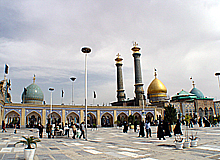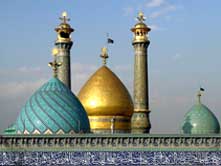The holy shrine
The holy shrine of Hazrat Abdolazim Hassani (pbuh) together with the noble shrine of Hazrat Ham zeh as well as that of Taher in Shahr-e-Rey have served as one of the most renown places of pilgrimage and tourism of Iran since the third century up to now and have been embraced by the fans and favorites of the Household of the prophet(peace be upon him) and dispatches a throng of the people during the year to the place from different parts of Iran and the world. Yet, till years ago, this shrine of generosity, as a cultural and social center, did not have a consolidated, regular organization and the rulers of the country, from Qajar dynasty to Pahlavi era, despite their superficial, hypocritical attention given to this place, took action to directly or indirectly lull into oblivion these sacred places and made attempts to separate religion from politics through mischievous policies so that these places would be used merely as secluded places like cemeteries and worshipping places and the cultural, social institutions would distance themselves from them.
zeh as well as that of Taher in Shahr-e-Rey have served as one of the most renown places of pilgrimage and tourism of Iran since the third century up to now and have been embraced by the fans and favorites of the Household of the prophet(peace be upon him) and dispatches a throng of the people during the year to the place from different parts of Iran and the world. Yet, till years ago, this shrine of generosity, as a cultural and social center, did not have a consolidated, regular organization and the rulers of the country, from Qajar dynasty to Pahlavi era, despite their superficial, hypocritical attention given to this place, took action to directly or indirectly lull into oblivion these sacred places and made attempts to separate religion from politics through mischievous policies so that these places would be used merely as secluded places like cemeteries and worshipping places and the cultural, social institutions would distance themselves from them.
In the early years following the victory of Islamic revolution, the idea of saving and removing deprivation from southern parts of Tehran as well as reinforcing the moral place of the Holy shrine was strengthened and some limited activities such as erection of theological school of Hazrat Abdolazim at the former place of Reza Khan's tomb took place, however the existing pilgrimage atmosphere and surrounding potentials and possibilities and above all, the cultural, ethical atmosphere of the region did not conform at all with such sacred  place. On the other hand, due to lack of a suitable administrative, supervisory system, some misuses occurred and were seen regarding the finances and endowments of the shrine. On the same basis, in 1990 the leader of revolution, through a decree, appointed Hoj. Mohammadi Reyshahri as trustee of the sacred shrine of Hazrat Abdolazim and the sacred shrines of Emamzadeh Hamzeh and Taher. In part of the decree it reads: it is required that you take assiduous effort in safeguarding the finances and endowments and allocate the finances towards services to be rendered for pilgrims and the people of Shahr-e-Rey and for promotion of knowledge of the Household of the Prophet and towards fulfilling services for the deprived and the oppressed people while preventing from any misuses.
place. On the other hand, due to lack of a suitable administrative, supervisory system, some misuses occurred and were seen regarding the finances and endowments of the shrine. On the same basis, in 1990 the leader of revolution, through a decree, appointed Hoj. Mohammadi Reyshahri as trustee of the sacred shrine of Hazrat Abdolazim and the sacred shrines of Emamzadeh Hamzeh and Taher. In part of the decree it reads: it is required that you take assiduous effort in safeguarding the finances and endowments and allocate the finances towards services to be rendered for pilgrims and the people of Shahr-e-Rey and for promotion of knowledge of the Household of the Prophet and towards fulfilling services for the deprived and the oppressed people while preventing from any misuses.
Following establishment of new management and carrying out initial surveys and studies following steps were taken:
- Creation of a modern, dynamic structure for administrative organization
- Preparing legal, executive channels for the whole complex including official registration of the constitution
- Employing experienced counselors with the aim of drawing up a comprehensive project under the title of religious/national plan for development of Abdolazim holy shrine
- Establishing connection with organizations and institutions in charge and reporting the existing unsuitable conditions to high ranking officials in order to make use of their assistance
- Thus, an all-out development began in the holy shrine in all cultural, pilgrimage, development aspects and regular managerial organization of the shrine was introduced and physical development of the shrine was put into effect as of 1992 through 20 major projects(welfare, cultural, religious)(for details, refer to architecture and construction section).
Presently, the holy shrine, is equipped with about 700 officials as an independent institution under supervision of leader of revolution in administrative, financial, legal, endowments, developmental, cultural, economic, public relations and international fields rendering services to pilgrims.
